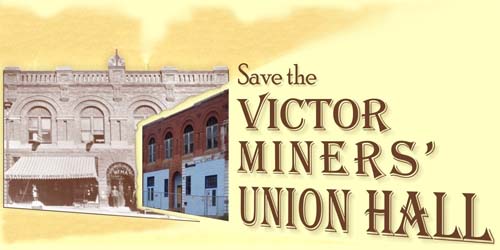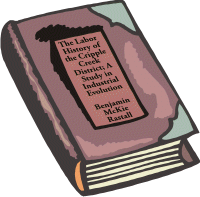 |
Victor
|
The Labor History of the Cripple Creek District;
A Study in Industrial Evolution
by Benjamin McKie Rastall

pages 9-18
Part I
THE STRIKE OF 1894
THE LABOR HISTORY OF THE CRIPPLE CREEK DISTRICT
CHAPTER I
PRELIMINARY CONSIDERATIONS
INTRODUCTION
The Cripple Creek District lies in the first range of the Rocky Mountains, about 25 miles west of Colorado Springs, and 85 miles southwest of Denver. It has an altitude of from 9,000 to 12,000 feet, none of the mines being at an elevation of less than 9,000, and some being over 11,000 feet above sea level. Geologically, the region is of volcanic origin. Great flows of lava have issued from a formerly existent volcano in the heart of the district. When these hardened they were subjected to severe stresses in the earths' crust and broken by countless fissures in parallel systems. Later, hot percolating
waters from deep-seated sources in the earth came to the surface, bearing in solution gold telluride, with quartz. These were deposited as the valuable ores in the fissure veins of the district.
Rough, gaunt, broken, dry and almost arid, cut into barren rocky ridges, and valleys along which scraggly dwarfed trees eke out a bare existence, and naught can flourish save the hardy mountain grasses and wild flowers;—it is not a place to invite human habitation, nor to support it under ordinary conditions. The only sign of occupancy in 1890 was the Womack cattle ranch occupying the present site of the city of Cripple Creek.
In 1893, less than three years later, the city of Cripple Creek numbered about 5,000 people, and close at hand were Victor, Anaconda, Altman, and numerous smaller towns. Three wagon roads led into the district, from Divide on the north, from Colorado Springs on the east, and from Canon City on the south. Along these roads night and day passed heavy trucks drawn by six and eight horses, bringing into camp provisions and building material and mining machinery, or leaving with loads of ore for the smelters. Heavy passenger coaches came in every night to crowd the number of fortune seekers. On the north the Colorado Midland Railway was running a branch road in from Divide, and the Florence and Cripple Creek Railway was pushing even harder to get into camp from the south.
The reason for this rapid change was gold. Mr. Robert Womack had in 1890 sunk prospect holes, and secured ore that assayed high in gold.1 News of his success had spread quickly, and soon prospectors were trooping in from all directions. By this time over 40 mines were in process of active development, and prospect holes were being sunk in every direction.2 Nearly $3,000,000 worth of ore had been shipped from the mines already, and every week new veins of rich promise were being opened.3
The social conditions of the region were those usual in an unsettled mining community. Life at the camp was generally rough. Men were many and women few. Saloons and dance halls were numerous. The roads were poor and the city streets even worse. Dumps from the mines often crossed the sidewalks, and half filled the streets. Houses were mere frame shells, or rough log huts. Prices of all merchandise were very high as the result of the 20 mile haul over mountain roads; the poorest shacks rented for $12 or $15 a month; fire wood was $4.50 per cord; and water sold for 5 cents a bucket or 40 cents a barrel.
GENERAL ECONOMIC CONDITIONS
Under these conditions Cripple Creek was rapidly becoming a great mining camp, when its development was arrested by a five-months' mincing strike. To fully understand this strike it is necessary to get its setting among surrounding conditions, and to see clearly the forces which acted as indirect causes or active impulses toward it. What conditions made a war between labor and capital imminent, and what influences led to the actual controversy.
In 1893 the United States was in the midst of a great financial panic. The expenditures of the government far surpassed its income. The reserve in the treasury was dangerously depleted, and the credit of the government was maintained by large bond issues. The business world was in a terrible condition. At the close of the year there had been over $500,000,000 withdrawn from National Banks alone. To meet the demand these banks had been compelled to withdraw loans to the extent of $318,000,000. Five hundred eighty banking institutions had been compelled to suspend payment, with liabilities of $165,000,000. There had been over 16,000 business failures. $1,200,000,000 worth of railroad property had gone into the hands of receivers. Thousands of shops and factories had shut down; more thousands were working part time only; commercial houses and railroads were working under greatly reduced business; and as a result millions of laborers were idle.4 It was estimated that in the city of Pittsburg [sic] alone 100,000 men were out of employment.5 In every city men were eager to seize an opportunity to work for their board alone, and rumors were current of men offering themselves as slaves for life for a promise of mere subsistence.
It was a time prolific of strikes. Contemporaneously with the Cripple Creek strike came a great coal miners strike, covering Pennsylvania, West Virginia, and Ohio, and the great Pullman strike, which starting in Chicago swept eastward half way to the Atlantic, and southward to the Gulf, and westward to the Pacific coast. Coxey's Army was marching toward Washington, a great body of the protesting unemployed, and a special session of Congress had been called to consider ways of relieving the great financial stress.
In Colorado the conditions were even worse than elsewhere. Added to the general depression had come the rapid decrease in the price of silver, the consequent closing of the silver mines, and the loss of one of the state's greatest sources of wealth.
The labor difficulties common to the country and the state were shared by Cripple Creek. Evidence of severe conditions is perhaps best given by the size of the detachment that left the district on May 4th to join Coxey's Army in the march to Washington. Over three hundred strong it left Cripple Creek and Victor, under the leadership of General J. S. Sanders, with flying colors and beating drums. The Florence and Cripple Creek Railway furnished a free train for the army to Canon City, and the Denver and Rio Grande did the same to Pueblo. At Pueblo the men were fed and housed for a few days, and then took forcible possession of a Missouri Pacific train, and started off for Chicago. The officials of the road tried in every way to stop them, and at last wrecked a train to block the track. But the Coxey men cleared away the wreck and went on. They were forced to abandon their train by a second wreck in a cut, but stole another train a few hours afterward, and succeeded in getting half way across Kansas, where they were arrested, and finally dispersed by United States marshals.6
The labor difficulties incident to the closing of the silver mines fell upon Cripple Creek. To the great gold camp flocked the unemployed miners of the silver region, to find work in the gold mines, or to open prospect holes on their own account.
1Cripple Creek Illustrated, Warren & Stride, p. 11.
2vide mines listed by the Colorado Springs Stock Exchange early in 1894.
3Cripple Creek Illustrated, Warren & Stride, p. 23.
4See Cripple Creek District newspapers for May 4, and 5.
5Pueblo papers for May 5, and 6.
6Colorado and Kansas newspapers generally, for May 5-8, Inclusive.
NEXT: Uncertain business conditions — Irregularities in employment of labor